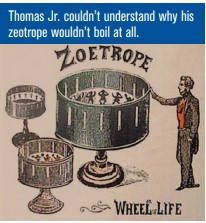For many, many years I’ve found the word “zeotrope” disconcerting and upsetting. I didn’t know why; it just irked me. When I was in high school studying chemistry, we learned about azeotropes, unusual mixtures of liquids, which didn’t distill when they boiled. Nobody mentioned zeotropes.
I have two dictionaries at home from that era. Neither mentions zeotropes. When I search “zeotrope” online it rather sniffily replies, “did you mean ‘zoetrope’?,” and tells me that a zoetrope is a 19th century form of moving pictures invented in 1834 and predates cinema by about 50 years. I received over 2 million hits for zoetrope and less than half a million for zeotrope, most of which seemed to be misspellings of the moving picture device.
Azeotrope is in the dictionary as “any liquid mixture which distills over without decomposition in a certain ratio,” and also gives about 2 million hits on Google. The word azeotrope was coined by an english chemist, John Wade, in 1911. Wade lectured at Guy’s Hospital in London and was the author of a comprehensive textbook on organic chemistry, first published in 1897.
According to Google’s excellent Ngram Viewer, which graphs the use of words over time, the popularity of azeotrope peaked in the late 1940s, possibly due to the publication of a patent by Lake and Stribley in 1944 titled, “The Azeotropic Distillation of Hydrocarbon Mixtures,” (U.S. Patent No. 2,477,303). Since then its use has steadily declined (as a percentage of all words used), and the efforts of the refrigeration world since 1986 don’t even register on the graph. The vast majority of the appearances of zeotrope in Ngram are misspellings of the moving picture device, but its first use as a chemical term seems to have been around 1920. Since the 1940s, its frequency of occurrence (including misspellings) has never been more than 1% of the use of azeotrope.
Azeotropes are recognized in ASHRAE’s refrigerant numbering nomenclature as the 500 series and were first developed as refrigerants in the 1950s. The first registered, R-500, was produced by Carrier as a higher capacity alternative to R-12 and was used in centrifugal chillers that had been designed for the 60 Hz North American market when they were used in the 50 Hz European market. It was a blend of CFC-12 (73.8%) and HFC-152a (26.2%) and was marketed as “Carrene 7.” R-501 was a mixture of CFC-12 and HCFC-22, which gave improved oil return characteristics to R-22 systems, and R-502 was a mixture of HCFC-22 and CFC-115, which produced lower compression ratios in low temperature plant and therefore gave improved reliability in single stage systems because the discharge temperature was lower.
At first I thought zeotrope was a false etymology, so I stuck to the term non-azeotrope. However, the “a” prefix is an indicator of privation, as the linguists would say, so removing it to indicate the opposite is fair and reasonable. It’s not like saying the opposite of “attraction” must be “traction.” Much more recently I worked out that the reason for my discomfort was the realization that being an azeotrope was a very specific, unusual condition, shared only by a rare group of mixtures.
Not being an azeotrope is situation normal for most things. Describing something as a zeotrope is like introducing myself as “I’m a non-violinist.” There’s no need because except in unusual circumstances, for example backstage after a string orchestra concert, almost everybody is the same in that regard, almost everyone else is a non-violinist too. So I’ve concluded there’s nothing wrong, linguistically, with zeotrope, even though it’s not in the dictionary. I just need to chillax a bit more.

